Protecting and restoring Ann Arbor's natural areas and fostering an environmental ethic among its citizens.
Volume 24, Number 2
Summer 2019
Park Focus: Kuebler Langford Nature Area
Amy Lipson, Crew Leader
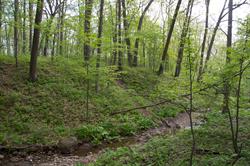
The forested ravine at Kuebler Langford Nature Area
Sunlight on my arms makes the air feel warmer than it is. With the sweat of trail work making the dust and grass stick to my skin, I lean on my mattock and turn my face into the southerly spring breeze and smile. The melodious refrain of the Song Sparrows cover the din of the highway and the whole crew has long ago left our coats forgotten in a heap near the trail. At Kuebler Langford, there is always trail work to do. Despite our constant battle with erosion, this natural area offers a gorgeous compilation of prairie and forest, with the equally lovely forests of Hilltop Nature Area inconspicuously stitched onto the northern half.
Past the entrance just off West Huron River Drive, the earth is a faded scar. Used as a staging area in the 1970s for the construction of the bend in M-14, the topsoil was scraped off to build the overpass, while the remaining earth was compacted into a sandy, gravely plate. While you can still see patches of the hard, bare earth, most of the ground is now hidden under the feathery blanket of prairie grasses and wildflowers. Last fall, we burned the prairie to spur new growth of native plants, and then over winter we laid down native seed. Our hope is that new plants will take hold and keep the soil in place, while also providing habitat for pollinators.
You may walk through the prairie and wonder why there are so many red-cedars on the ground. They are native, aren't they? Why did we cut them all down? Red-cedar plays a role in succession as a transitional element that shades and protects trees that aren't as hardy while they develop a foothold in what would otherwise be a hot, dry, and windy place. The progression of prairies into savannas and then forests may be ancient and natural, but we are running out of prairie. Without the natural disturbances that sustain prairies, we are losing them to the wheel of succession, and not gaining many new ones. So we pump the brakes, and slow down that wheel. Without the red-cedar to offer shelter, our forest hardwoods can't get a foothold, and the prairie stays a prairie.
In case you, like a shagbark hickory, can't handle the heat of the open prairie, Kuebler Langford and Hilltop Nature Area also offer a lovely forest, with plants I haven't seen anywhere else in our parks. Though not the rarest treasure here, my favorite sight is the wild sarsaparilla. A relative of ginseng, it has three compound leaves that cover the blooms like an umbrella. Hidden under their shadow, the flowers make globe-shaped clusters like pale fireworks, inches from the forest floor. Finding them feels like digging up treasure. A variety of birds and mammals enjoy the purple fruit that follows soon after the flowers fade.
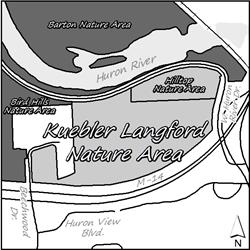
Wandering through the cool, rich forest, you won't even know when you cross the line from Kuebler Langford into Hilltop Nature Area, though a faded trail sign identifying some natural feature will clue you in soon enough. The city purchased the formerly named Camp Hilltop from the Girl Scouts of Huron Valley after a fire in 2006 destroyed their main building. It boasts thrilling views from its steep slopes. On one side, there is the oxbow bend in the Huron River, with all the birds that prefer the slower waters there, and on the other side, a deep valley runs along the length of the park, prolific in the spring with the demure, downturned flowers of the trout lily.
Spring and summer are the best times to ensure that this forest remains high-quality, so the conservation crew sweeps the steep hillside for any herbaceous invasive plant that might infiltrate our woods. As we brace our feet perpendicular to the slope and grip trees for balance, the reddest bird I've ever seen flashes through the trees. The Scarlet Tanager prefers larger, un-fragmented forests, so the connected woods of Kuebler Langford, Hilltop, Barton, and Bird Hills offer habitat our smaller parks can't. Preventing invasive plants from crowding out our native ones ensures that beauties like the Scarlet Tanager have tasty insects and berries for many years to come.
If you feel the same as the Scarlet Tanager, driven to explore wider tracks of natural beauty, the continuity that Kuebler Langford and Hilltop offer will appeal to you. You can work your way from park to park, finding connections and working your way through the city. Perhaps you're using these connections to make your run less repetitive, as is popular here, but come back later for a slower exploration. Maybe you'll find a little toad, or a red-backed salamander. Or perhaps you'll find the elusive spicebush and enjoy its fragrance, or admire the delicate fronds of a maidenhair fern.
Join us for workdays at Kuebler Langford on June 22 and August 11. See the
calendar for details
Coordinator's Corner: Ann's Arbor- part 1
Dave Borneman, Natural Area Preservation Manager
NAP's process for restoring our open oak woodlands has always been a slow and deliberate one: prioritize our sites of highest ecological quality (those with the most natives and the fewest invasives); and then work in a surgical manner to remove those unwanted invaders without impacting the natives. It's been relatively easy to get public support for removing things like European Buckthorn shrubs, whose very name tells you that it's not native, it's a shrub, and it has thorns, which some people find objectionable. After that, we've moved on to controlling things like Norway Maple trees – also clearly non-native, but it's a tree, with pretty fall foliage, and no thorns. A little harder to garner public support for removing pretty trees, but when they hear our reasoning, most folks can support that as well.
So, after removing all the non-native trees and shrubs, is our work done to restore our native oak woodlands? Unfortunately, no. Notice that I'm using the term “open oak woodland" to describe this native ecosystem. Some might call it an “oak savanna." Our City founders called it an “arbor" – “Ann's Arbor." Others at the time used the term “oak opening" to describe the open, park-like setting with large, open-grown oak trees scattered across the landscape. We have many colorful descriptions of this landscape in the 1820-30s from early travelers to the Ann Arbor area. Karl Neidhard wrote, “The dense forests disappear … and park-like woods, which the Americans call 'oak openings' meet the traveler's eye… where the trees stand a few paces apart and where the ground is overgrown with luxurious grass. Passage is obstructed neither by bushes nor by fallen trees." J.W. Wing said, “The plains were covered at intervals as far as the eye could reach with wide-spreading forest trees which gave it the appearance of an immense park." And John M. Gordon declared, “Oaks of the circumference of 9-15 feet abound in the forests… White Oak and Burr Oak at intervals of 30-40 feet…"
THIS is the vision that NAP has for our highest quality natural areas! THIS is our natural heritage here in “Ann's Arbor!" It's not just about removing the non-native trees and shrubs. It's about opening up the canopy and letting in more sunlight to support a groundcover that is “overgrown with luxurious grass" (probably Pennsylvania sedge). And where “passage is obstructed neither by bushes nor by fallen trees." J.W. Wing described it this way: “The scene was beautiful beyond description. The timber consisted of large oak trees standing several rods apart and the intermediate space between them was covered with bright green grass and beautiful flowers… It did appear as if one-half of the vegetation was flowers. Most of them were about eighteen inches high and when moved by the wind the effect was wonderful. I have never seen in any of our large cities a park that was its equal."
So, how do we reclaim this natural heritage? That will be the subject of my next installment in the fall newsletter. Until then, if you'd like to read more of these wonderful historic quotes, check out NAP's webpage. Or take a stroll through Furstenberg Nature Area, where we're having some early success in this effort.
Scarlet Tanager: A Winged Beauty
Juliet Berger, NAP Ornithologist
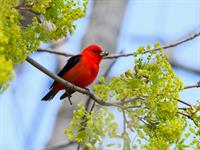 Male Scarlet Tanager
Male Scarlet Tanager
Follow me to Bird Hills Nature Area, Ann Arbor's largest nature area, which overlooks Huron River Drive near Barton dam. On a clear early morning in May, we hear a varied chorus of bird song. There's a cacophony of sound now, more than we can process, so we breathe for a few minutes and take it in. The woods smell green and damp with dew. Some spring ephemeral wildflowers still linger in the shade, especially the May-apple, with its green umbrella and hidden white flowers, just beginning to turn to green fruit. Among the birds we hear is the American Robin, with his clear “Cheerio, Cheer-up" song echoing through the forest. Listen, there is a bird singing now, with a hoarse voice, very much like the Robin we just heard, but this fellow sounds like he has a sore throat — we've encountered the elusive male Scarlet Tanager.
Since Scarlet Tanager males are scarlet red with black wings and tail, we ought to easily pick him out among the green leaves of the towering trees overhead. But Scarlet Tanagers are canopy nesters and thrive in the upper branches, in foliage which is fairly leafed out by this time of year, so at first he eludes us. Also, he is singing without fluttering about and drawing attention to himself, so he's even stealthier than we thought. Finally we spot him, shining out like a red beacon from a branch tip, croaking out his steady five-phrase song, “Churry, burry, flurry, hurry, worry." As we raise our binoculars, we get to see his bill open with each phrase, projecting his song into the morning air. What a treat!
Scarlet Tanagers are long-distance migrants to our area, nesting only in tracts of mature deciduous trees or mixed deciduous and coniferous forest. They arrive in Ann Arbor and other areas in eastern North America in late April to early May, and stay only to nest and raise one brood of young. When the young are strong and grown, parents and their young make the up-to 5,000 mile journey to their wintering grounds in South American rainforests, in lowlands just east of the Andes. There, they feed on insects and fruit, foraging with other species with similar dietary needs, both resident and migratory species.
Scarlet Tanagers eat mostly insects and other invertebrates during the breeding season, and feed their young this diet as well, with the occasional berry for variety. The olive-green female, who also sings, builds the nest without the help of the male, from fine plant fibers lined with soft rootlets and pine needles. She incubates the 3-5 eggs by herself, while the male sings constantly, to defend their territory. Once the young hatch, both parents make many trips to the nest with juicy bugs for the nestlings. After about 2 weeks, the young fledge from the nest, though the parents continue to feed them for several more weeks before they disperse.
Other natural areas in Ann Arbor also may harbor the colorful Scarlet Tanager. Explore eBird for reports of current locations of this bird (www.ebird.org), or visit Marshall Nature Area, Kuebler Langford Nature Area, Scarlett Mitchell Nature Area, and Huron Hills Golf Course Woods to look and listen for Tanagers. Natural Area Preservation (NAP) maintains these high-quality, mature woodlands through controlled burns, cutting of invasive shrubs like honeysuckle, and pulling of invasive plants, such garlic mustard. Those of us who volunteer for NAP workdays and burns help keep areas like Bird Hills a healthy home for the Scarlet Tanager and many other fascinating and unusual species of plants and animals.
For more information about the Scarlet Tanager and other North American birds, visit www.allaboutbirds.org or www.washtenawaudubon.org and come along on one of our NAP-sponsored bird walks. We'll be birdwatching at the Wheeler Service Center on June 2, from 7:30-9:30 a.m. See the
calendar for more details.
NAPpenings
Welcome, new Park Steward!
Tom Armsrong
Sugarbush Park
Thanks and Congratulations to these Boy Scouts who completed their Eagle Scout projects in our parks
Justin Alexander
New trail at Earhart Park
Thank you!
Many thanks to the groups who volunteered with NAP recently. We could not make such a difference without you!
Ann Arbor Running Fit
Bodman PLC
Community High School
Duo Security
Early College Alliance Student Leaders
Ecovia Renewables
EMU VISON Volunteer Center
UM Alpha Chi Sigma
UM Circle K
UM Delta Sigma Pi
UM Ecological Issues Class
UM Industrial Operations Engineering Classes
UM Postdoctoral Association
UM Running Club
UM Tau Beta Sigma
UM Young Life College Campus Ministry
YMCA Youth Volunteer Corps
YSA Ann Arbor
Correction
In our spring newsletter, we misidentified white, or concolor, fir as Douglas fir. Here's how to tell the difference between these similar species.
Douglas fir (left)
Pseudotsuga menziesii
· Needles are brighter green and more crowded onto the stem.
· Buds are pointed.
· Needles are soft and less fragrant than white firs.
White fir (right)
Abies concolor
· Needles are longer, more grayish blue, and spaced out along the stem.
· Buds are rounded.
· Needles are thick, leathery, and very fragrant.
Lookout for Japanese Stiltgrass
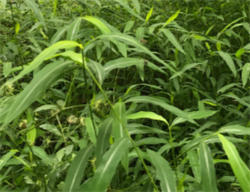 Japanese stiltgrass has been found in Washtenaw County. This non-native grass can spread very quickly. It has short, alternate, lance-shaped leaves, with a pale, off-center mid-rib. The roots can grow from the nodes, giving it the appearance of stilts.
Japanese stiltgrass has been found in Washtenaw County. This non-native grass can spread very quickly. It has short, alternate, lance-shaped leaves, with a pale, off-center mid-rib. The roots can grow from the nodes, giving it the appearance of stilts.
If you see this plant, please let us know immediately, and report it using the MISIN online tool: www.misin.msu.edu/report
For more information:
www.michigan.gov/invasives.
Staff Updates
Farewell...
 Sean-Levin Pompetzki, Field Crew
Sean-Levin Pompetzki, Field Crew
Although my season with NAP has been short, I have learned a lot. I appreciate the knowledge and experience I have gained, and for the new opportunities, such as prescribed fire. I am continuing my career in natural resources, this time with the National Park Service. Thank you NAP for the opportunity you have given me.
Welcome...
 Krissy Elkins, Workday Coordinator
Krissy Elkins, Workday Coordinator
I am so lucky to be part of the team of wonderful people dedicated to preserving and restoring our natural areas. I am a graduate of the University of Michigan in Ecology and Evolutionary Biology and I have spent time working for the UM Herbarium. Now it is time to shift from curated flowers to the real thing! I look forward to organizing workdays that help connect anyone and everyone to our beautiful planet.
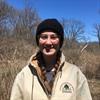 Becca Naumenko, Field Crew
Becca Naumenko, Field Crew
I am so excited to be joining the NAP crew. During my time at U of M, I volunteered with NAP and really loved it. The volunteers and staff were exceptionally kind, and getting the chance to help our local community felt great. I can't wait to experience that environment again, along with the chance to breathe some fresh air. I grew up in the U.P. and since coming south, my time outdoors has been limited. So I'm looking forward to some time in the woods!
Would you like to be part of the NAP Staff team? Follow the city jobs website (a2gov.org/jobs). Positions can open throughout the year. NAP also has unpaid internships that provide valuable experience! For internship information contact NAP directly: [email protected] or 734.794.6627.
Fight the Bite
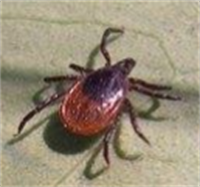
Blacklegged Tick
Lyme disease is spread by the bite of an infected blacklegged tick (Ixodes scapularis), also known as a deer tick. Untreated Lyme disease can produce a wide range of symptoms, including fever, rash, facial paralysis, arthritis, and more. Prompt diagnosis and treatment with antibiotics can cure the infection and prevent later complications.
Lyme disease is an emerging issue in our community. The following have occurred locally:
· In 2018, the 5 cases of Lyme disease in Washtenaw County were all likely from local exposure.
· The State of Michigan conducted tick dragging and collection in Nichols Arboretum and Bird Hills in 2018. Blacklegged ticks were found in both of these locations.
· A blacklegged tick was recently found in Rolling Hills Waterpark. The tick tested negative for Lyme. However, this indicates that the species of tick that carries Lyme disease has been found in the eastern part of the county.
· Blacklegged ticks found in the northwest part of Washtenaw County near Pinckney/Waterloo Recreation Areas in fall 2016 tested positive for Lyme.
We urge you to "fight the bite" against ticks and tick-borne disease. Transmission season for Lyme disease in Michigan typically occurs from May through August, with a peak in June. The Washtenaw County Health Department recommends the following precautions to prevent Lyme disease:
1. Avoid direct contact with ticks.
2. Repel ticks with DEET or permethrin repellent.
3. Conduct tick checks.
4. Remove embedded ticks by using tweezers.
5. Submit ticks for identification and testing to the Michigan Department of Health and Human Services.
You can find this information and a lot more about Lyme disease and tick identification at www.washtenaw.org/lyme.
